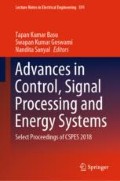Abstract
This work presents a new idea for human behavior recognition based on dictionary learning algorithm and collaborative representation-based classification approach. In this paper, we have proposed an l1 – ls-based KSVD algorithm for learning a dictionary and collaborative representation is used in the classification phase for this problem. The performance of our proposed idea for human behavior recognition problem establishes the superiority of our new idea.
Access this chapter
Tax calculation will be finalised at checkout
Purchases are for personal use only
References
Debes C, Merentitis A, Sukhanov S (2016) Monitoring activities of daily living in smart homes: understanding human behaviour. IEEE Signal Process Mag 33(2):81–94
Erden F, Velipasalar S, Alkar AZ (2016) Sensors in assisted living: a survey of signal and image processing methods. IEEE Signal Process Mag 33(2):36–44
Wright J, Yang A, Ganesh A, Sastry S, Ma Y (2009) Robust face recognition via sparse representation. IEEE Trans Pattern Anal Mach Intell 31(2):210–227
Yang J, Wang J, Huang T (2011) Learning the sparse representation for classification. In: Proceedings of IEEE International Conference on Multimedia Expo (ICME), July 2011, pp. 1–6
Elad M, Aharon M (2006) Image denoising via sparse and redundant representations over learned dictionaries. IEEE Trans Image Process 15(12):3736–3745
De P, Chatterjee A, Rakshit A (2018) Recognition of human behavior for assisted living using dictionary learning approach. IEEE Sens J 18(6):2434–2441
Aharon M, Elad M, Bruckstein A (2006) K-SVD: an algorithm for designing overcomplete dictionaries for sparse representation. IEEE Trans Signal Process 54(11):4311–4322
Elad M (2010) Sparse and redundant representations: from theory to applications in signal and image processing. Springer, Berlin
Donoho D, Tsaig Y (2006) Fast solution of l1 norm minimization problems when the solution may be sparse (preprint)
Yang A, Ganesh A, Zhou Z, Sastry S, Ma Y (2010) Fast l1 minimization algorithms and an application in robust face recognition: a review. Technical report UCB/EECS-2010-13, UC Berkeley
Bruckstein A, Donoho D, Elad M (2007) From sparse solutions of systems of equations to sparse modeling of signals and images. SIAM review (in press)
Hale E, Yin W, Zhang Y (2007) A fixed-point continuation method for ` 1 l regularized minimization with applications to compressed sensing. Technical report CAAM Tech. rep. TR07-07, Rice University
Kim S, Koh K, Lustig M, Boyd S, Gorinevsky D (2007) An interior-point method for large-scale `1- regularized least squares. IEEE J Sel Top Sig Proc 1(4):606–617
Kojima M, Megiddo N, Mizuno S (1993) Theoretical convergence of large-step primal-dual interior point algorithms for linear programming. Math Program 59:1–21
Malioutov D, Cetin M, Willsky A (2005) Homotopy continuation for sparse signal representation. In: ICASSP
Figueiredo M, Nowak R, Wright S (2007) Gradient projection for sparse reconstruction: application to compressed sensing and other inverse problems. IEEE J Sel Top Sig Proc 1(4):586–597
Zhang L, Yang M, Feng X (2011) Sparse representation or collaborative representation which helps face recognition?. In: Proceedings of ICCV
UCI machine learning repository. Dataset for ADL recognition with wrist-worn accelerometer data set. https://archive.ics.uci.edu/ml/datasets/Dataset+for+ADL+Recognition+with+Wrist-worn+Accelerometer
Author information
Authors and Affiliations
Corresponding author
Editor information
Editors and Affiliations
Rights and permissions
Copyright information
© 2020 Springer Nature Singapore Pte Ltd.
About this paper
Cite this paper
De, P., Chatterjee, A., Rakshit, A. (2020). Human Behavior Recognition: An l1 – ls KSVD-Based Dictionary Learning and Collaborative Representation-Based Classification. In: Basu, T., Goswami, S., Sanyal, N. (eds) Advances in Control, Signal Processing and Energy Systems. Lecture Notes in Electrical Engineering, vol 591. Springer, Singapore. https://doi.org/10.1007/978-981-32-9346-5_8
Download citation
DOI: https://doi.org/10.1007/978-981-32-9346-5_8
Published:
Publisher Name: Springer, Singapore
Print ISBN: 978-981-32-9345-8
Online ISBN: 978-981-32-9346-5
eBook Packages: EngineeringEngineering (R0)

